One glass of grapefruit juice can be harmless for most people. But if you’re taking an immunosuppressant after a transplant, that same glass could send your drug levels into the danger zone-fast. This isn’t a myth. It’s not a warning you can afford to ignore. In fact, it’s one of the most dangerous food-drug interactions in modern medicine.
Why Grapefruit Is a Hidden Threat
Grapefruit doesn’t just taste tart-it contains powerful chemicals called furanocoumarins. These compounds shut down an enzyme in your gut called CYP3A4, which normally breaks down certain medications before they enter your bloodstream. When that enzyme is blocked, your body absorbs way more of the drug than it should. For immunosuppressants, that means your blood levels can spike by 50%, 100%, or even 300% in just a few hours.This isn’t theoretical. Back in 1989, researchers in Canada accidentally discovered this effect while studying how grapefruit juice affected a blood pressure drug. They found that patients who drank grapefruit juice had nearly three times the drug concentration in their blood. Since then, dozens of studies have confirmed the same pattern with transplant medications like cyclosporine, tacrolimus, and sirolimus.
Which Immunosuppressants Are at Risk?
Not all immunosuppressants react the same way. But the ones that do are critical to your survival after a transplant. These include:- Cyclosporine (Sandimmune, Neoral)
- Tacrolimus (Prograf, Envarsus XR, Astagraf XL)
- Sirolimus (Rapamune)
- Everolimus (Zortress) - added to the high-risk list in 2023
All of these drugs have three things in common: they’re absorbed through your gut, they’re broken down by CYP3A4, and they have a very narrow safety window. That means the difference between the right dose and a toxic one is tiny. For example, a safe tacrolimus level is 5-15 ng/mL. A level above 20 ng/mL can cause serious kidney damage, tremors, or even seizures. Grapefruit can push you over that line after just one glass.
How Much Grapefruit Is Dangerous?
You don’t need a whole fruit. You don’t even need a full glass. As little as 200 milliliters-less than a cup-of grapefruit juice is enough to trigger a major interaction. And it’s not just juice. Fresh grapefruit, pomelo, and even Seville oranges (used in marmalade) contain the same harmful compounds. Even grapefruit extract in supplements or flavored water can be risky.And here’s the part most people don’t realize: the effect lasts for days. Once furanocoumarins bind to your gut enzymes, they don’t just turn off when the juice is gone. The inhibition lasts up to 72 hours. So even if you eat grapefruit on Monday, your body is still vulnerable on Wednesday when you take your next dose of tacrolimus.
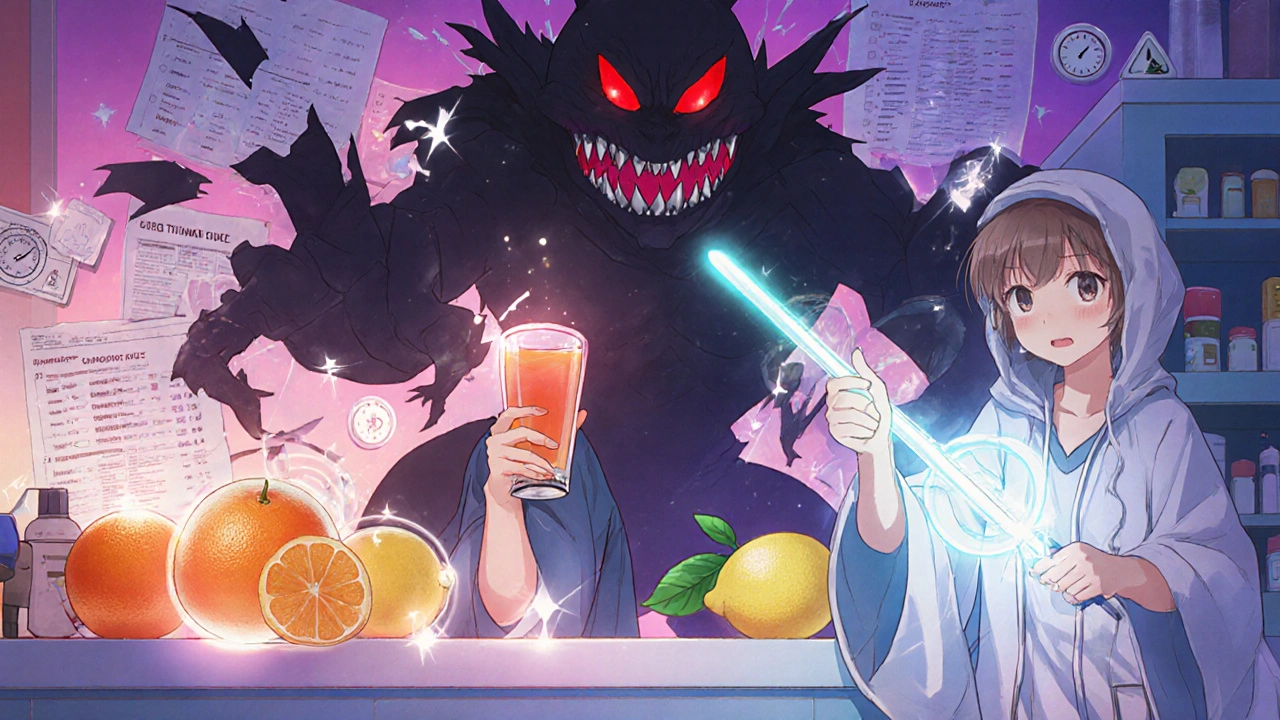
What Happens When Levels Go Too High?
Too much immunosuppressant doesn’t make you more protected-it makes you more vulnerable. High drug levels suppress your immune system too much, leaving you open to serious infections. But they also damage your organs. Common signs of toxicity include:- Severe kidney pain or reduced urine output
- High blood pressure
- Tremors or shaking hands
- Nausea, vomiting, or diarrhea
- Unusual fatigue or confusion
- High potassium levels (hyperkalemia), which can trigger heart rhythm problems
Real patients have been hospitalized because of this. One kidney transplant recipient in a 2022 online forum reported his tacrolimus levels jumped from 8.2 ng/mL to 24.7 ng/mL after drinking grapefruit juice. His doctor said it was a near-fatal spike. Another person on Reddit described shaking so badly they thought they were having a seizure. These aren’t rare cases. Transplant pharmacists report that 15-20% of unexpected toxicity cases they see are linked to grapefruit consumption.
Why Do So Many People Still Eat It?
Grapefruit is healthy. It’s packed with vitamin C, fiber, and antioxidants. The American Heart Association even gives it their heart-check mark. That’s why so many transplant patients think, “I’ll just have a little.”But the problem isn’t just ignorance. A 2023 survey by the British Liver Trust found that 68% of transplant patients still don’t fully understand how dangerous grapefruit is. Some think the warning only applies to juice. Others believe they can time it-eat grapefruit in the morning and take their pill at night. That doesn’t work. The enzyme damage lasts for days.
And it’s not just older patients. Younger transplant recipients, who are more likely to follow health trends or drink “detox” juices, are increasingly at risk. One 2023 study found that patients under 40 were 30% more likely to consume grapefruit than older patients, despite being just as vulnerable to the interaction.
What Should You Do Instead?
The answer is simple: avoid it completely. No exceptions. No “sometimes.” No “just once.”Transplant centers across the U.S. and Europe now have clear guidelines:
- Avoid all grapefruit products-juice, fruit, zest, extract, or supplements
- Check labels-some bottled juices, smoothies, and salad dressings contain grapefruit
- Ask your pharmacist-if you’re unsure about a product, don’t guess
- Swap it out-oranges, tangerines, lemons, and limes are safe alternatives
And if you’ve accidentally consumed grapefruit? Call your transplant team immediately. Most centers recommend checking your drug levels within 24-48 hours. Some protocols suggest reducing your dose by 25-50% until results come back.
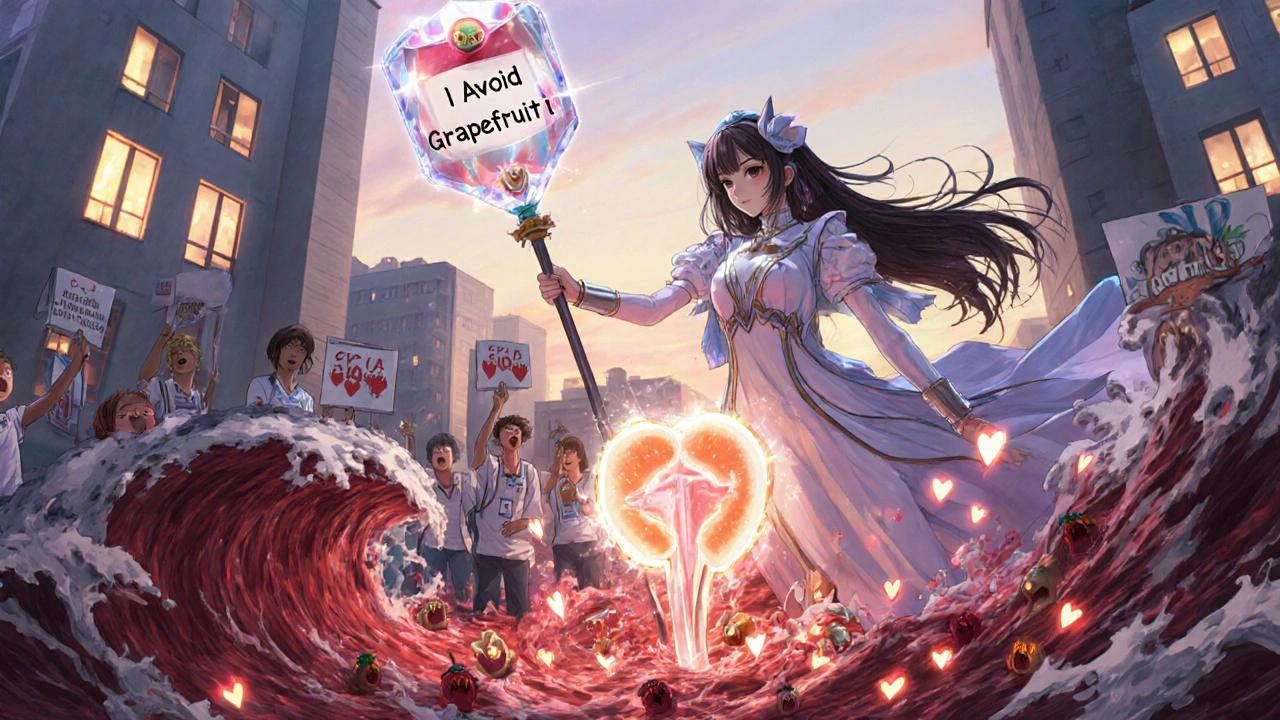
What About Newer Medications?
Pharmaceutical companies know this is a problem. That’s why newer versions of some drugs, like Envarsus XR (a slow-release form of tacrolimus), were designed to be less affected by food. But don’t assume they’re safe. Even these formulations still interact with grapefruit-just to a lesser degree. The FDA still lists them as high-risk.There’s also emerging research on ways to block the interaction. One 2022 study found that taking activated charcoal within an hour of eating grapefruit reduced enzyme inhibition by 60%. But this is still experimental. It’s not a recommended solution. And it doesn’t work for everyone. The only guaranteed safety is avoidance.
What’s Being Done to Protect Patients?
Since 2010, the FDA has required grapefruit interaction warnings on the labels of high-risk medications. Many pharmacies now print bright red stickers on immunosuppressant bottles. Johns Hopkins launched a mobile app in early 2023 that scans your medication barcode and instantly alerts you if grapefruit is a risk.But technology can’t replace education. Transplant centers are now training nurses to ask patients directly: “Have you eaten grapefruit in the last three days?” That question is becoming standard in every follow-up visit.
And it’s working. In centers that use structured patient education programs, grapefruit-related toxicity cases have dropped by over 40% in the past five years. The key? Making the risk personal. Not just “avoid grapefruit,” but “this one fruit could kill your new kidney.”
The Bottom Line
You’ve fought hard to get a transplant. You’ve followed every rule, taken every pill, shown up for every appointment. Don’t let one fruit undo it all. Grapefruit might be good for your heart, but it’s deadly for your new organ. There’s no safe amount. No safe time. No safe exception.If you’re on cyclosporine, tacrolimus, sirolimus, or everolimus-don’t eat it. Don’t drink it. Don’t even think about it. Your life depends on keeping your drug levels steady. And grapefruit is the one thing that can throw it all off.
Ask your pharmacist. Ask your doctor. Print out the warning. Put it on your fridge. This isn’t a suggestion. It’s a survival rule.

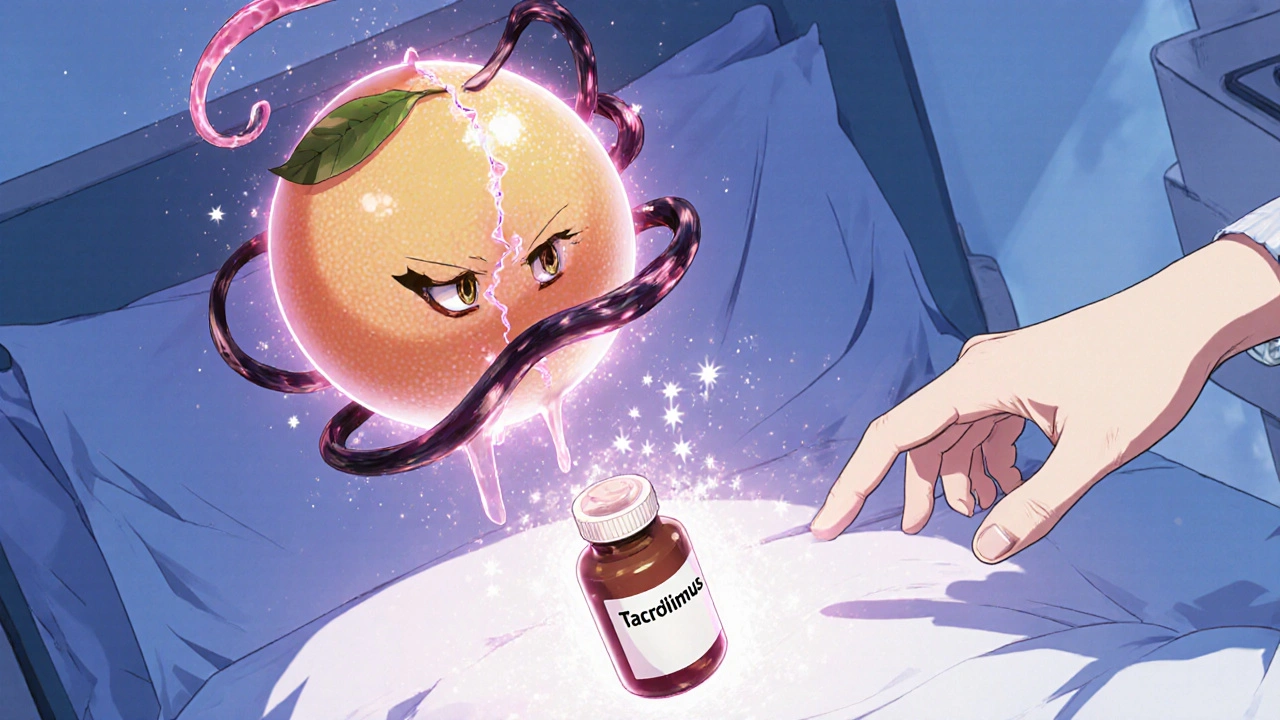

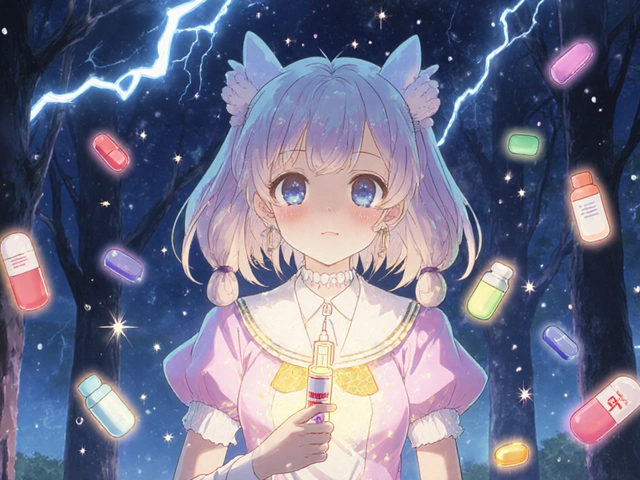
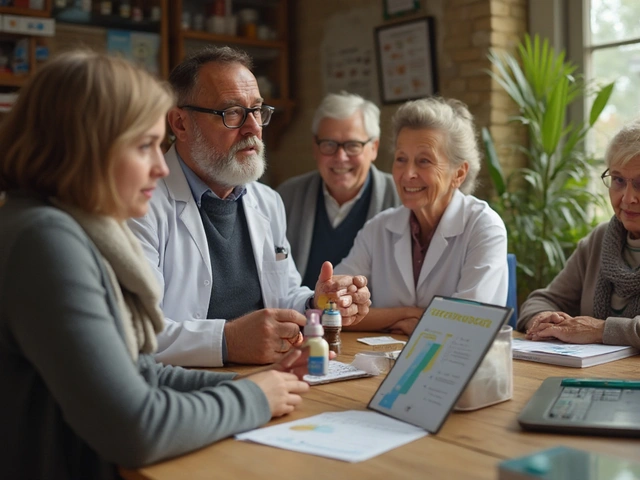
Victoria Short
Just read this and immediately deleted my grapefruit smoothie recipe. Holy crap.
Jessica M
As a clinical pharmacist specializing in transplant medicine, I cannot stress this enough: grapefruit is not a harmless indulgence for transplant recipients. The pharmacokinetic interaction with CYP3A4 is not only well-documented but clinically catastrophic. Even trace amounts in flavored waters or zest can trigger toxic drug accumulation. We have seen patients admitted for acute renal failure after consuming a single segment of grapefruit. The 72-hour enzyme inhibition window is non-negotiable. There is no safe threshold. This is not an advisory-it is a life-or-death imperative.
Koltin Hammer
You know what’s wild? People still think ‘natural’ means ‘safe.’ Grapefruit is literally a bioactive chemical weapon against your meds. It’s not about being healthy-it’s about being alive. Your kidney didn’t come with a warranty. You don’t get a do-over. One sip, one fruit, one moment of ‘I’ll just have a little’ and you’re back in the hospital with a new set of problems. I’ve sat across from too many people who thought they were being smart by eating ‘clean.’ Turned out they were just eating their way into rejection.
Eric Gregorich
Think about it-your body is a battlefield. You’ve got this foreign organ inside you, and your immune system is like a hyperactive guard dog that needs to be sedated just to not eat it alive. And then along comes grapefruit, this innocent-looking citrus that doesn’t just distract the guard dog-it knocks out the entire security system. Now the dog’s running loose, and your new kidney is just sitting there thinking, ‘Wait, I thought we had a deal?’ The tragedy isn’t that people eat it-it’s that they think they can outsmart biology with willpower. You don’t negotiate with enzymes. They don’t care if you’re ‘good’ or ‘disciplined.’ They just react. And they don’t forgive.
Rebekah Kryger
Actually, the whole grapefruit warning is overblown. I’ve been on tacrolimus for 8 years, drank grapefruit juice daily, and my levels are fine. The studies are all funded by pharma to push expensive alternatives. Also, some people metabolize differently. Genetic polymorphisms in CYP3A4 mean the interaction isn’t universal. Why are we treating everyone like they’re a lab rat? Maybe we should be testing individual enzyme activity instead of blanket bans. This is medical overreach disguised as caution.
Willie Randle
Rebekah, I hear you-but this isn’t about individual variation. It’s about risk management. Transplant centers don’t ban grapefruit because they think everyone reacts the same-they ban it because the consequences of one mistake are irreversible. A single patient with a 300% spike in tacrolimus can die before the lab results come back. That’s not a ‘maybe.’ That’s a known, documented, preventable death. We don’t have the luxury of personalized risk assessments for every food. We have one rule: zero grapefruit. Period. Your ‘I’m fine’ doesn’t override the data. Your life doesn’t exist in a vacuum.
Connor Moizer
Stop being a coward. If you can’t give up a fruit that tastes like sour regret, then maybe you don’t deserve a new kidney. This isn’t a diet. This is your body’s last chance. You think your ‘genetic exception’ makes you special? It makes you a liability. You’re not a scientist-you’re a patient. And patients who ignore warnings don’t get second chances. So either cut the grapefruit out or go back to dialysis. No one’s holding your hand.
Phil Best
Let’s be real: grapefruit is the villain in every transplant movie. The fruit that kills. The citrus of betrayal. I’ve seen grown men cry when they realized they’d been drinking grapefruit juice for months. One guy thought it was ‘healthy’ because his influencer said so. Spoiler: influencers don’t have kidneys. The FDA sticker on the bottle? It’s not decoration. It’s a funeral notice waiting to happen. Don’t be the guy who turns his transplant into a cautionary TikTok.
Parv Trivedi
I am from India, and here many people drink citrus juices daily. After reading this, I shared this with my cousin who had a kidney transplant last year. She had no idea about grapefruit danger. Now she switched to orange juice and feels relieved. We must spread awareness-not just in the West. In many countries, this warning is not part of patient education. A simple poster in clinics can save lives. Knowledge is the real medicine here.
kanishetti anusha
I’m a transplant patient too, and I used to love grapefruit. I thought ‘just a little’ wouldn’t hurt. Then I had a tremor so bad I dropped my coffee. My levels were 27. I was in the ER for three days. Now I drink lemon water every morning. It’s not the same, but I’m alive. To anyone reading this: please, don’t wait for your body to scream. Silence is the loudest warning.
Erika Lukacs
It’s ironic, isn’t it? We’ve engineered drugs to precisely modulate the immune system, yet nature-through a single fruit-retains the power to dismantle our entire medical architecture. The grapefruit, in its quiet, tart way, reminds us that biology does not negotiate with human intention. We build systems of control, but the body remembers its own rhythms. The enzyme doesn’t care about your schedule, your willpower, or your ‘healthy lifestyle.’ It simply reacts. And in that reaction, we are forced to confront the limits of our control. Perhaps the real lesson isn’t to avoid grapefruit-but to accept that some things cannot be tamed.
roy bradfield
They’re lying about grapefruit. It’s all a cover-up. The real reason they ban it is because the pharmaceutical companies make billions from drug monitoring and emergency care. They don’t want you to know that vitamin C and antioxidants can naturally regulate immunosuppressants. The ‘72-hour inhibition’? A myth invented by lab rats in white coats. They’re scared you’ll figure out you don’t need their expensive meds if you just eat more citrus. I’ve been eating grapefruit for 10 years with no issues. My levels are perfect. They’re just trying to keep you dependent. Wake up. The system is rigged. And they’re using ‘safety’ to control you.